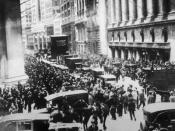"No one can possibly have lived through the Great Depression without being scared by it. No amount of experience can convince someone who has lived through it that the world is economically safe." - Isaac Asimov
The Great Stock Market Crash of 1929 and the Depression that followed is perhaps one of the most memorable and unforgettable events in the 19th century. The economy began to pick up after World War I. The nation was looking for easy money to compensate for the losses in the war. The stock market became the answer. Best of all, anyone could do it; just borrow money on margin, invest it in a company, and receive a big return. Shares continued to rise as with the number of investors. But no boom lasts forever and accordingly, the "inflating stock bubble" had to burst sooner or later. On Thursday, October 24, 1929, also known as "Black Thursday," the crash began.
A record of 17 million stocks changed hands. Investors scrambled to sell their investments at a fraction of the price. An estimated loss of $26 million occurred that day. America was sent into a state of insecurity, panic, and poverty - Depression. The Great Depression is not only important to those that lived during the 1920s and 30s, but also to the present population and economy. Economists, advisors, and investors are careful not to allow history repeat itself. Hence, "Was the Crash and Depression avoidable?" No. In the early stages of the post-war boom, problems with the economy were already introduced. Unfortunately, nothing could be done to fix them. Particularly, the large portion of "artificial" stock trading and the maldistribution of income and wealth could only lead to disaster - which would be the unavoidable Crash of 1929 that would lead to the Great Depression.


